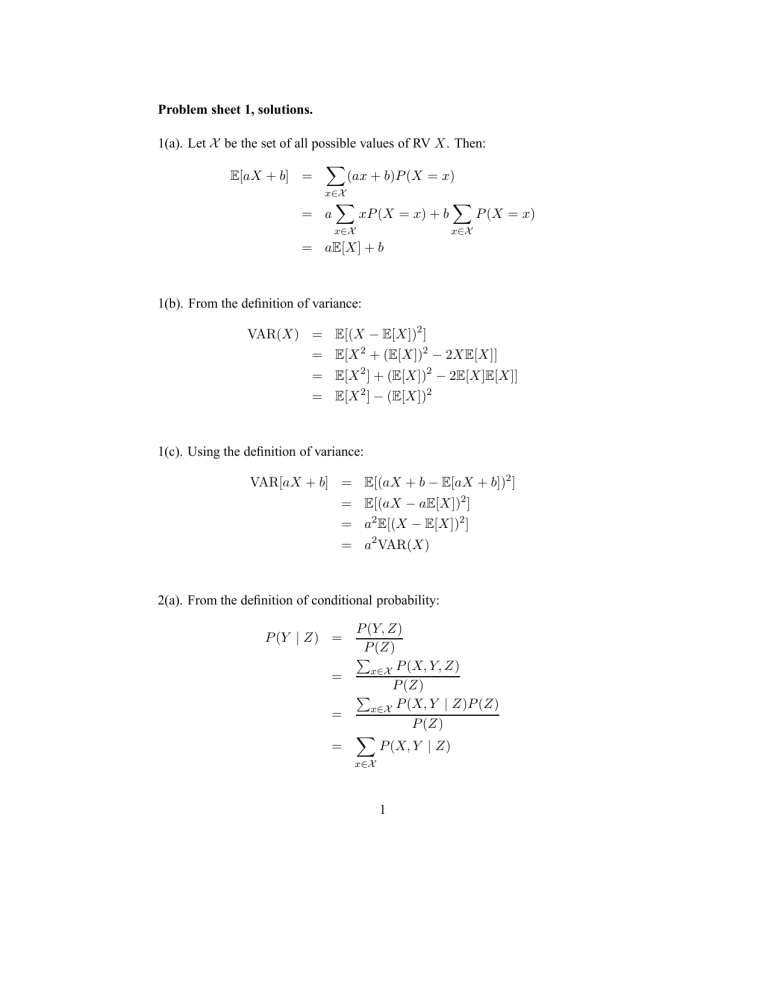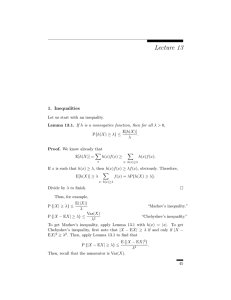Problem sheet 1, solutions. 1(a). Let X

Problem sheet 1, solutions.
1(a). Let X be the set of all possible values of RV X . Then:
E [ aX + b ] =
X
( ax + b ) P ( X = x ) x ∈X
= a
X xP ( X = x ) + b
X
P ( X = x ) x ∈X
= a E [ X ] + b x ∈X
1(b). From the definition of variance:
VAR( X ) = E [( X − E [ X ]) 2 ]
= E [ X 2 + ( E [ X ]) 2
= E [ X
2
] + ( E [ X ])
2
− 2 X E [ X ]]
− 2 E [ X ] E [ X ]]
= E [ X
2
] − ( E [ X ])
2
1(c). Using the definition of variance:
VAR[ aX + b ] = E [( aX + b − E [ aX + b ]) 2 ]
= E [( aX − a E [ X ])
2
]
= a
2
E [( X − E [ X ])
2
]
= a
2
VAR( X )
2(a). From the definition of conditional probability:
P ( Y | Z ) =
=
=
=
P ( Y, Z )
P ( Z )
P x ∈X
P ( X, Y, Z
P ( Z )
)
P x ∈X
P ( X, Y | Z ) P ( Z )
P ( Z )
X
P ( X, Y | Z ) x ∈X
1
2(b). From the definition of conditional probability:
P ( X, Y | Z ) =
=
P ( X, Y, Z )
P ( Z )
P ( X | Y, Z ) P ( Y, Z )
P ( Z )
=
P ( X | Y, Z ) P ( Y | Z ) P ( Z )
P ( Z )
= P ( X | Y, Z ) P ( Y | Z )
3. From the sum rule:
P ( Y ) =
=
X
P ( X, Y ) x ∈X
X
P ( Y | X ) P ( X ) x ∈X
Substituting into the denominator of Bayes’ rule gives the required result.
4. Using the product rule:
P ( X
1
, X
2
. . . X n
) = P ( X
2
. . . X n
| X
1
) P ( X
1
)
Applying the “conditional product rule” to the first term on the RHS:
P ( X
2
. . . X n
| X
1
) = P ( X
3
. . . X n
| X
1
, X
2
) P ( X
2
| X
1
)
Which gives:
P ( X
1
, X
2
. . . X n
) = P ( X
3
. . . X n
| X
1
, X
2
) P ( X
2
| X
1
) P ( X
1
) get:
Again, applying the “conditional product rule” to the first term on the RHS, we
P ( X
1
, X
2
. . . X n
)
= P ( X
4
. . . X n
| X
1
, X
2
, X
3
) P ( X
3
| X
1
, X
2
) P ( X
2
| X
1
) P ( X
1
)
Repeatedly applying the conditional product rule to the first term on the RHS in this way leads to the required result.
2
5. Let B be a RV representing the identity of the box which actually contains the key, such that B = 1 , B = 2 and B = 3 mean that the key is contained in box # 1,
# 2, # 3 respectively. Similarly let S ∈ { 1 , 2 , 3 } represent the box selected by Bill, and R ∈ { 1 , 2 , 3 } the box his boss has chosen to reveal. Without loss of generality, assume that Bill has selected box # 1, and that his boss has chosen to reveal box
# 3, i.e.
S = 1 , R = 3 . We are interested in the probability that the key lies in box
# 1, conditioned on S = 1 and R = 3 , i.e.
P ( B = 1 | S = 1 , R = 3) . If this probability is less than 1 / 2 Bill should switch.
Now, consider the conditional pmf P ( R | B, S ) . If we assume (i) the boss cannot choose to reveal the box which Bill has already selected, (ii) the boss cannot choose to reveal the box which actually has the key, and (iii) if the box already selected by Bill contains the key, she chooses at random from the other two boxes, we can write:
P ( R = i | B = j, S = k ) =
0 if i = j ∨ i = k
1 if j = k ∧ i = j
1
2 if j = k
(1)
We make a fourth assumption, namely that in the absence of any other information, the key is equally likely to lie in any of the three boxes, such that
1
P ( B = j ) =
3 for j = 1 , 2 , 3 . Then, using Bayes rule:
P ( B = 1 | R = 3 , S = 1)
=
P ( R = 3 | B = 1 , S = 1) P ( B = 1 | S = 1)
P j ∈{ 1 , 2 , 3 }
P ( R = 3 | B = j, S = 1) P ( B = j | S = 1)
(2)
Finally, we make a fifth assumption, namely that the location of the key cannot be changed after Bill makes his initial selection (i.e. no cheating!). This means
1
P ( B | S ) = P ( B ) =
3
. From (2) and (1):
P ( B = 1 | S = 1 , R = 3) =
=
1
2
1
·
1
3
1
2
· 1
3
+ 1 ·
1
3
3
Bill should therefore switch.
3





